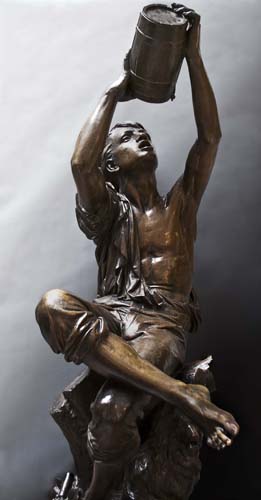From the Collection: The Water Boy

In this monthly installment of the From the Collection series, we feature the bronze sculpture, The Water Boy, by French artist Frédéric-Auguste Bartholdi.
Every month, DrexelNow dives in to the treasures of The Drexel Collection, which includes decorative arts, prints, drawings, textiles, an 18th-century David Rittenhouse clock, 19th-century paintings and much more.
A bronze sculpture known as The Water Boy sits on the first floor at the base of the staircase in Main Building’s Great Court. This life-size sculpture, initially entitled The Young Vine-Grower and then The Alsatian Vintner, was created by French artist Frédéric-Auguste Bartholdi (1834-1904) in 1869. Many may know Bartholdi for another of his creations, the Statue of Liberty.
The sculpture shows a young man in 19th-century Alsatian clothing, seated on a tree stump with his dog at his side. He is about to drink from a wine keg. Bartholdi was born in Colmar, Alsace, France, an important wine trading center. Seemingly, this image was familiar to the artist and the inspiration for the sculpture.
The sculpture was exhibited in the principal French room in Memorial Hall at the Centennial International Exhibition in Philadelphia in 1876 along with other bronze sculptures and fountains by the artist. As a prominent Philadelphia citizen, Anthony J. Drexel participated in the Centennial. His personal architect, Joseph M. Wilson, was the engineer for Memorial Hall, the art gallery for the Centennial, as well as the engineer for the Main Exhibit Building, considered the largest building in the world at that time at 21.5 acres.
Anthony Drexel’s connection to Bartholdi developed with his membership in the Franco-American Union, a committee devoted to raise funds for the pedestal of the Statue of Liberty. The Water Boy is from the personal collection of Anthony J. Drexel; curators from the Drexel Collection speculate that he may have purchased the sculpture at the Centennial.
The Water Boy serves as a sort of good-luck charm for the University community. The tradition at Drexel is that students rub the toe of the sculpture for good luck during examinations. This has left the toe a bright, shiny bronze and attests to the sculpture’s long history at the University.
--Jacqueline DeGroff, Curator of the Drexel Collection
Drexel News is produced by
University Marketing and Communications.